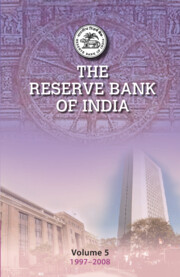Book contents
- Frontmatter
- Contents
- Tables
- Boxes
- Foreword
- Preface
- Acknowledgements
- List of Abbreviations
- 1 Introduction: Managing Liberalisation
- 2 The Macroeconomic Context
- 3 Monetary Management
- 4 Foreign Exchange Market and Management of the Capital Account
- 5 Foreign Exchange Reserves Management
- 6 Financial Markets
- 7 Public Debt Management
- 8 The Payment and Settlement Systems
- 9 Currency Management
- 10 Regulation of the Financial System – Part I: Commercial Banks
- 10 Regulation of the Financial System Part II: Other Financial Institutions
- 11 Supervision of the Financial System
- 12 Rural Credit
- 13 Financial Inclusion
- 14 Communication Policy
- 15 Organisational Change
- Appendices
- Photographs
- Select Bibliography
- Index
2 - The Macroeconomic Context
Published online by Cambridge University Press: 10 January 2023
- Frontmatter
- Contents
- Tables
- Boxes
- Foreword
- Preface
- Acknowledgements
- List of Abbreviations
- 1 Introduction: Managing Liberalisation
- 2 The Macroeconomic Context
- 3 Monetary Management
- 4 Foreign Exchange Market and Management of the Capital Account
- 5 Foreign Exchange Reserves Management
- 6 Financial Markets
- 7 Public Debt Management
- 8 The Payment and Settlement Systems
- 9 Currency Management
- 10 Regulation of the Financial System – Part I: Commercial Banks
- 10 Regulation of the Financial System Part II: Other Financial Institutions
- 11 Supervision of the Financial System
- 12 Rural Credit
- 13 Financial Inclusion
- 14 Communication Policy
- 15 Organisational Change
- Appendices
- Photographs
- Select Bibliography
- Index
Summary
Introduction
Between 1997–98 and 2007–08, the Reserve Bank of India functioned in a fast-changing economic environment. The two defining features of the process of change were the continuation of the economic liberalisation process begun earlier and the increasing openness of the Indian economy. This chapter provides a review of these two developments and a descriptive account of the behaviour of key macroeconomic variables during the period under reference. The review will serve as a backdrop to the succeeding chapters dealing with the Reserve Bank’s policies and operations.
Three themes dominate the narrative: growth, institutional change and openness. During the reference period, India maintained relatively high economic growth, with an intervening period of slowdown. A debate exists on when the economy moved to a higher growth path, to which a reference will be made later in the chapter. The higher growth rate, especially in the latter half of the reference period, was supported by growing domestic savings and investment rates, besides capital flows from abroad. Despite frequent changes of governments, political stance was generally in favour of continuing with economic and financial sector reforms initiated in the early 1990s. Interestingly, more than any other sector of the economy, the services sector propelled growth; services came to occupy a dominant share in the gross domestic product (GDP).
Inflation was relatively moderate despite high monetary and credit expansion. However, increasing global oil prices and domestic food price inflation started exerting pressure on prices towards the end of the period. Crucial to Reserve Bank operations, the fiscal situation at both the centre and states gradually improved after 2003. This was achieved thanks to cooperative efforts taken by the government and the Bank to contain deficits at sustainable levels by introducing rule-based fiscal reforms. India’s external sector expanded owing to increasing openness and progressive liberalisation of current and capital account transactions. Growth in the invisibles, especially remittances, supported the current account, where deficit was near-persistent, and unprecedented capital inflows sustained the overall balance of payments position.
The Reserve Bank coordinated closely with the government to sustain the growth process, contain inflation and maintain financial stability through banking and financial sector reforms.
- Type
- Chapter
- Information
- The Reserve Bank of IndiaVolume 5, 1997–2008, pp. 14 - 43Publisher: Cambridge University PressPrint publication year: 2023



